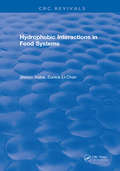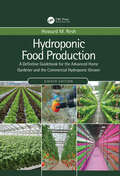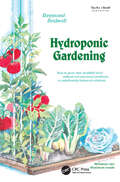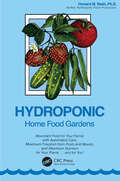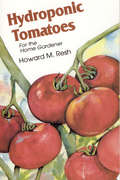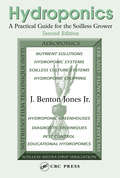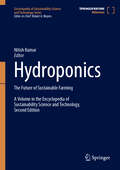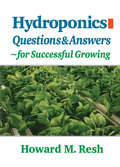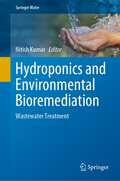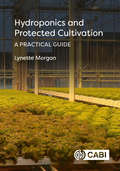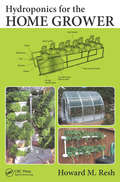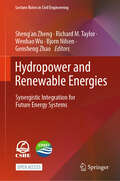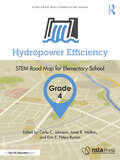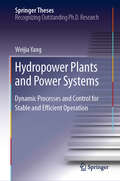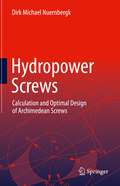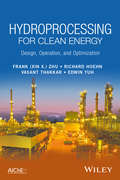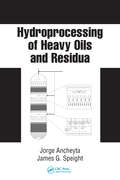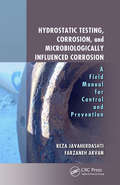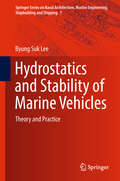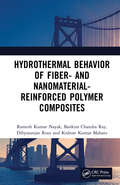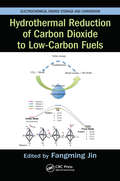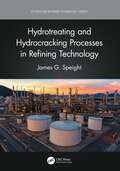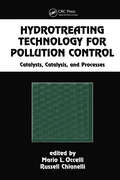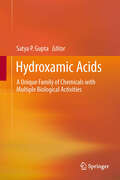- Table View
- List View
Hydrophobic Interactions in Food Systems
by Shuryo NakaiThis book aims to assist scientists in the field in reviewing and updating their information, and will prompt them to adopt a unified quantitative approach to the study of hydrophobic interactions in food systems. The first part of this monograph reviews the current knowledge on the topic, and the second part of the monograph presents in some detail, an example of the application of hydrophobic concept to a particular food system, namely muscle proteins.
Hydroponic Food Production: A Definitive Guidebook for the Advanced Home Gardener and the Commercial Hydroponic Grower
by Howard M. ReshThe eighth edition of Hydroponic Food Production: A Definitive Guidebook for the Advanced Home Gardener and the Commercial Hydroponic Grower serves as a comprehensive guide to soilless culture (hydroponics) for hobby and commercial growers. Extensively updated from the seventh edition published in 2013, this bestseller is a "methods" book to show the reader how to set up a hydroponic operation with the options of using any of many hydroponic cultures presently used in the industry to grow vegetable crops. Written by Dr Howard M. Resh, a recognized authority worldwide on hydroponics, the book presents detailed information on hydroponic growing systems and features more than 600 photographs (200 in full color), drawings, and tables. New to this edition: Presents greenhouse environmental control systems and examples of sustainable greenhouse technology, and demonstrates uses of automation and robotics in harvesting, grading, and packing. Introduces indoor vertical farming, and vertical growing systems, as well as the expansion of tropical hydroponics and rooftop greenhouses. Provides information on automation in large-scale raft culture and nutrient film technique (NFT) operations in the growing of lettuce, leafy greens, and herbs. A new chapter 12 discusses control of environmental factors in greenhouses. It covers information on systems to regulate temperature, relative humidity, carbon dioxide enrichment, lighting, and fertigation with examples of sustainable greenhouse technology. This chapter demonstrates automation in the regulation of the greenhouse environment to crop production methods with emphasis on robotics in harvesting to transporting, grading, and packing equipment. The use of retractable roof structures in tropical, humid climates is an alternative for growing greenhouse crops. A new chapter 14 describes vertical indoor farming. It presents background information on early vertical greenhouses and sack culture systems to present vertical systems used by greenhouses and existing vertical greenhouses and future concepts. Vertical indoor farming reviews systems of vertical tiers of shelving growing lettuce, leafy greens, and herbs under LED lighting in large warehouses. The chapter exemplifies automation in these vertical farms with each specific system and it contains information on vertical growing in containers and/or modular units. Chapter 15 contains new information on tropical hydroponics describing hydroponics in Peru. Expansions of rooftop greenhouses with new locations in New York, Chicago, and Montreal display updated facilities and crops.
Hydroponic Gardening: How To Grow Vital, Healthful Food Without Soil and insect Problems in Nutritionally Balanced Solutions
by Raymond BridwellA guide to the magic of modern hydroponics for the home gardener. The author seeks to write from experience, using basic, easy-to-use methods.
Hydroponic Hijinks (Astrid the Astronaut #3)
by Rie NealIn this third book in the Astrid the Astronaut chapter book series, Astrid is torn between her best friend and arch-rival!The Shooting Stars and Petite Picasso groups are working together on a combined STEM and art project—which means BFFs Astrid and Hallie finally get to team up! But Astrid&’s excitement doesn&’t last long when they are grouped with her arch-nemesis: Pearl. And what&’s worse, Hallie actually agrees with some of the ideas Pearl has for the project. Isn&’t she supposed to be on Astrid&’s side? Can Astrid, Hallie, and Pearl learn how to work together and create a project that&’s out of this world?
Hydroponic Home Food Gardens
by Howard M. ReshA manual exploring modern hydroponic methods. It addresses several forms of hydroponic gardening, covering materials and methods, the selection of the best plants for the home gardener, and principles and practice for the successful propagation and nurturing of food plants.
Hydroponic Tomatoes
by Howard M. ReshYou don't need previous experience. Your advantages (besides great tomatoes!) include freedom from harmful pesticides, bothersome weeds and insects, plus ease and pleasure in tending the garden. And you can enjoy your tomatoes sooner . . . tomatoes rich in vitamins and minerals and great taste! Step-by-step instructions, with many clear, "show-me-h
Hydroponics: A Practical Guide for the Soilless Grower
by J. Benton Jones Jr.Revolutionary hydroponic/soilless advances are being achieved by efficiently improving results with the application of new concepts, methods, and equipment. The new edition of a bestseller, Hydroponics: A Practical Guide for the Soilless Grower has been revised to reflect these advances with new chapters that provide essential information on greenh
Hydroponics: The Future of Sustainable Farming (Encyclopedia of Sustainability Science and Technology Series)
by Nitish KumarThis handbook covers both principal and applications aspects of hydroponics. This reference book shows the state-of-the-art in this area, while offering a clear view of supplying plants with nutrients other than soil. Chapters about hydroponics provides the reader with an understanding of the properties of the various soilless media and how these properties affect plant performance in relation to basic agricultural operations, such as fertilization and irrigation. Chapters explore the drawbacks and advantages of using hydroponics as a soilless crop production system and provide a wider view of science, technology, and economic impact of hydroponics. This book is a valuable resource to agriculturists, horticulturalists, greenhouse and nursery managers, and professionals involved with the production of plants. The handbook provides chapters about technology and applications of hydroponics. It contains an overview of the relevance of aquaponics in the fulfillment of the SDGs.
Hydroponics: Questions & Answers for Successful Growing
by HowardM. ReshFirst published in 2002. CRC Press is an imprint of Taylor & Francis.
Hydroponics and Environmental Bioremediation: Wastewater Treatment (Springer Water)
by Nitish KumarBioremediation is the use of biological interventions for mitigation of the noxious effects caused by pollutants in the environment including wastewater. It is very useful approach for a variety of applications in the area of environmental protection. It has become an attractive alternative to the conventional clean-up technologies that employ plants and their associated microorganisms to remove, contain, or render harmless environmental contaminants.Hydroponic systems, which utilize plants which are grown in a nutrient solution without soil, are expanding and raising great interest in the commercial and scientific community. They are engineered systems designed and constructed to utilize the natural processes involving macrophytes, media, and the associated microbial assemblages to assist in treating wastewaters. This is a relatively new approach in wastewater treatment by which a variety of emergent macrophytes are grown hydroponically on top of floating platforms with their roots developing freely into the flowing wastewater. The roots provide a support medium for attached microbial growth which participates in the treatment process.
Hydroponics and Protected Cultivation: A Practical Guide
by Dr Lynette MorganA comprehensive, practical text which covers a diverse range of hydroponic and protected cropping techniques, systems, greenhouse types and environments. It also details the use of indoor plant factories, vertical systems, organic hydroponics and aquaponics. Worldwide hydroponic cropping operations can vary from large, corporate producers running many hectares of greenhouse systems particularly for crops such as tomato, cucumber, capsicum and lettuce, to smaller-scale growers growing fresh produce for local markets. Included in this book: Detailed technical information to help growers and students to design and run their own hydroponic operations. In-depth research to explain the factors that influence plant growth, produce quality, post-harvest life and hydroponic plant nutrition. New advances such as the use of organic nutrients and substrates, completely enclosed indoor plant factories and the growing number of small-scale, non-commercial applications. Hydroponics and Protected Cultivation is fully illustrated with colour images and photographs to illustrate key topics and help identify problem areas. It is suitable for growers, researchers and students in horticulture.
Hydroponics for the Home Grower
by Howard M. ReshHydroponics offers many advantages to traditional soil-based horticulture. These include greater control over many of the limiting factors, such as light, temperature, and pests, as well as the ability to grow plants in all seasons. With instruction from one of the top recognized authorities worldwide, Hydroponics for the Home Grower gives you step
Hydropower and Renewable Energies: Synergistic Integration for Future Energy Systems (Lecture Notes in Civil Engineering #487)
by Sheng’an Zheng Richard M. Taylor Wenhao Wu Bjorn Nilsen Gensheng ZhaoThis open access book explores the complementarity of hydropower with new energy sources such as solar and wind in the global energy transition. It analyzes the technological advantages, environmental impacts, and economic potential of combining hydropower and new energy sources, while examining the related policies and market mechanisms. Through a multidimensional approach, the book demonstrates the importance of this energy integration in improving energy system efficiency, reducing carbon emissions, and promoting sustainable development. Starting with the challenges and strategies of technology integration, the book will explore the role of smart grid management and energy storage technologies in this context, providing quantitative and qualitative assessments of the ecosystem and socio-economic impacts of such energy synergies. Valuable knowledge and practical guidance for energy researchers, policy makers and professionals in the field of sustainable development.
Hydropower Efficiency, Grade 4: STEM Road Map for Elementary School (STEM Road Map Curriculum Series)
by Carla C. Johnson Janet B. Walton Peters-Burton, Erin E.What if you could challenge your fourth graders to create a minimally invasive, highly efficient dam? With this volume in the STEM Road Map Curriculum Series, you can! Hydropower Efficiency outlines a journey that will steer your students toward authentic problem solving while grounding them in integrated STEM disciplines. Like the other volumes in the series, this book is designed to meet the growing need to infuse real-world learning into K–12 classrooms.This interdisciplinary, four-lesson module uses project- and problem-based learning to help students create a highly efficient dam that has a minimal impact on the environment. Students will explore the use of natural resources to provide energy needs, specifically hydropower, while exploring the workings of watermills, wind turbines, and generators to help build an understanding of the effects of dams. In creating their dam, they will learn about the various types of alternative hydropower sources, including wave and tidal power, and track the progress of electrification in the U.S. on a timeline; alongside researching the positive and negative consequences of hydropower.To support this goal, students will do the following: Use the engineering design process (EDP) to create a design for a dam, wind turbine, and water wheel Compare and contrast renewable power sources Evaluate power sources for efficiency Identify positive and negative consequences of human modifications of the environment Identify and describe how several sources of renewable energy are used across the U.S. Use mapping skills to determine where natural resources are being accessed for energy usage Effectively utilize shapes, materials, and measurements to create a model of a hydropower system The STEM Road Map Curriculum Series is anchored in the Next Generation Science Standards, the Common Core State Standards, and the Framework for 21st Century Learning. In-depth and flexible, Hydropower Efficiency can be used as a whole unit or in part to meet the needs of districts, schools, and teachers who are charting a course toward an integrated STEM approach.
Hydropower Plants and Power Systems: Dynamic Processes and Control for Stable and Efficient Operation (Springer Theses)
by Weijia YangThis book reports on a comprehensive study addressing the dynamic responses of hydropower plants under diverse conditions and disturbances, and analyzes their stability and oscillations. Multiple models based on eight existing hydropower plants in Sweden and China were developed and used for simulations and theoretical analysis with various degrees of complexity and for different purposes, and compared with on-site measurements for validations. The book offers important insights into the understanding of the hydraulic, mechanical and electrical coupling mechanisms, up to market conditions and incentives. It recommends control strategies for a more stable and efficient operation of hydropower plants.
Hydropower Screws: Calculation and Optimal Design of Archimedean Screws
by Dirk Michael NuernbergkWater screw conveyors have been in use for centuries. Their invention is attributed to Archimedes. However, the idea of using this Archimedean screw also as a hydropower screw to convert hydraulic energy into electrical energy did not emerge until the 1990s. More recently, hydropower screws have been used very frequently at hydropower sites and have now also attracted increasing interest from scientists and users worldwide. This is due to the machine's very good efficiency, it's simple and inexpensive design, and its fish compatibility. This book provides calculation fundamentals for hydropower screws. The author focuses on the description of the hydraulic processes and gives a design flow that can be used to design hydropower screws. The hydraulic behavior, dimensions, speed, efficiency, forces acting on the screw such as sag or lift, as well as the arrangement of the gearbox and the choice of generator are discussed. The theoretical equations, some of which are newly derived, are applied using examples. Finally, a design flow is given that can be used to easily adapt an optimally designed hydropower screw to a location. New findings presented in various scientific publications have been incorporated into the translation of the second German edition. In addition, experiments were carried out at different locations, which led to a better understanding of the available data basis. This has allowed the theoretical predictions of this book to be confirmed experimentally. In addition, the author has investigated a number of faulty installations and has been involved in the design of successful working waterpower plants equipped with hydropower screws.
Hydroprocessing for Clean Energy: Design, Operation, and Optimization
by Edwin Yuh Frank Xin Zhu Richard Hoehn Vasant ThakkarProvides a holistic approach that looks at changing process conditions, possible process design changes, and process technology upgrades Includes process integration techniques for improving process designs and for applying optimization techniques for improving operations focusing on hydroprocessing units. Discusses in details all important aspects of hydroprocessing - including catalytic materials, reaction mechanism, as well as process design, operation and control, troubleshooting and optimization Methods and tools are introduced that have a successful application track record at UOP and many industrial plants in recent years Includes relevant calculations/software/technologies hosted online for purchasers of the book
Hydroprocessing of Heavy Oils and Residua (Chemical Industries)
by Heinz Heinemann James G. SpeightMany oil refineries employ hydroprocessing for removing sulfur and other impurities from petroleum feedstocks. Capable of handling heavier feedstocks than other refining techniques, hydroprocessing enables refineries to produce higher quality products from unconventional- and formerly wasted- sources. Hydroprocessing of Heavy Oils and Residua
Hydrostatic Testing, Corrosion, and Microbiologically Influenced Corrosion: A Field Manual for Control and Prevention
by Reza Javaherdashti Farzaneh AkvanHydrostatic Testing, Corrosion, and Microbiologically Influenced Corrosion: A Field Manual for Control and Prevention teaches industry professionals, managers, and researchers how to combat corrosion failure associated with hydrotesting. It discusses how a test liquid must be selected, how corrosion by bacteria should be controlled, and how to eliminate the risk of leakage. Rather than teaching how hydrotests should be conducted, it helps the reader evaluate the quality of a hydrotest that’s already been conducted in terms of oxygen scavenger use, biocide testing, inhibitor addition, and water quality and explains the tasks that top and middle management must ensure are taken with respect to corrosion assessment of hydrotesting. The manual also discusses microbiologically influenced corrosion (MIC) as the main corrosion mechanism related to post-hydrotesting and offers essential knowledge on combating this corrosion process. In addition to being a manual for top and middle management on how to deal with corrosion, this book also:
Hydrostatics and Stability of Marine Vehicles: Theory and Practice (Springer Series on Naval Architecture, Marine Engineering, Shipbuilding and Shipping #7)
by Byung Suk LeeThis book addresses the hydrostatics and stability of ships and other floating marine structures - a fundamental aspect of naval architecture and offshore engineering for naval architects and marine engineers. It starts from the most basic concepts, assuming that the reader has no prior knowledge of the subject. By presenting the topic in a methodical and step-by-step manner, the book helps students to enhance their understanding, while also providing valuable guidelines for lecturers teaching related courses.
Hydrothermal Behavior of Fiber- and Nanomaterial-Reinforced Polymer Composites
by Bankim Chandra Ray Ramesh Kumar Nayak Dibyaranjan Rout Kishore Kumar MahatoHydrothermal Behavior of Fiber- and Nanomaterial-Reinforced Polymer Composites provides critical information regarding the in-service environmental damage and degradation studies of nano/fiber reinforced polymer (FRP) composites focusing on hydrothermal degradation. Covering hydrothermal properties of a wide range of polymer composites, the book is aimed at graduate students, researchers, and professionals in material engineering, composite materials, nanomaterials, and related fields.
Hydrothermal Reduction of Carbon Dioxide to Low-Carbon Fuels (Electrochemical Energy Storage and Conversion)
by Fangming JinThe book covers advances in hydrothermal reduction of CO2 into low-carbon fuels. It offers perspectives from chemical engineering, environmental chemicals, organic chemistry, inorganic chemistry, physical chemistry, geology and materials science. It addresses fundamentals and applications of hydrothermal chemical processes, associated materials, and technologies. It describes reduction with biomass and dissociation of water by solar energy-driven two-step process. Challenges and strategies are discussed to facilitate research and development.
Hydrotreating and Hydrocracking Processes in Refining Technology (Petroleum Refining Technology Series)
by James G. SpeightWritten by an industry expert with over 50 years of experience, this book details the various solvent processes that are used in crude oil refineries. Providing an in-depth exploration of the different types of processes, as well as the types of feedstocks that can be used with them, this book prepares readers for changes as the industry evolves. Key Features: Describes feedstock evaluation and the effects of elemental, chemical, and fractional composition. Contains an extensive glossary of all related concepts in hydrotreating and hydrocracking processes. Considers next-generation processes and developments. This book is an essential guide for engineers, scientists, and students in the field of petroleum processing and refining technology, including professionals, technicians, management personnel, and academics.
Hydrotreating Technology for Pollution Control: Catalysts, Catalysis, and Processes (Chemical Industries)
by Mario L. Occelli"Based on the American Chemical Society's Second Symposium on Advances in Hydrotreating Catalysts, held in Washington, D.C. Offers comprehensive coverage of the most recent progress in catalysis by transition metal sulfides for the creation of more environmentally safe catalysts and processes. Written by over 70 acclaimed experts from various field
Hydroxamic Acids
by Satya P. GuptaSatya P. Gupta's Hydroxamics Acids is the first book to compile invited articles written by international experts on the class of compounds hydroxamic acids. Found to possess a wide spectrum of biological activities, the hydroxamic acids are of interest to theoretical and experimental chemists who can study and make use of them in drug design and development. Chapters in this book provide a diverse and comprehensive coverage of this compound class and consequently this publication is a valuable resource for researchers in chemical, pharmaceutical and biological sciences.
